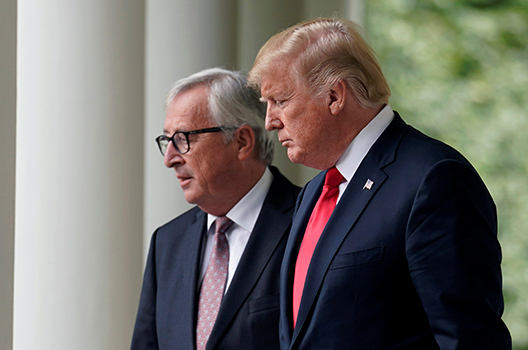Coming up on the anniversary of the July 2018 “trade truce” between European Commission President Jean-Claude Juncker and US President Donald J. Trump, little progress has been made in trade negotiations between the United States and the European Union. This article is the first in a series that will take stock of the opportunities in and challenges to the deepest trading relationship in the world and focuses on the current state of discussions.
The European Union (EU) and the United States have, over the decades, built the world’s most deeply integrated economic, trade, and investment relationship. Annually, the United States exports around $575 billion in goods and services to the EU, and imports approximately $684 billion. Services have become an increasingly important component of transatlantic trade flows, making up an estimated bilateral trade of around $450 billion in which the United States runs a $60 billion trade surplus. Trade in goods still accounts for the bulk of the relationship however, totaling more than $800 billion. The EU runs a trade surplus in the bilateral goods trade of approximately $170 billion.
Deep integration of trade and economies aside, several longstanding economic dynamics affect the transatlantic relationship and hinder its expansion. Among these are the reality that trade is much more important to the European economy than to the US one, the critical role of the US dollar as the most important global reserve currency and settlement currency for trade transactions, and disagreements on aspects of non-tariff barriers to trade and other policy areas that change through time but are always present, including politically charged issues such as food standards and agricultural subsidies.
The current US-EU trade dialogue stems from a joint statement by US President Donald J. Trump and European Commission President Jean-Claude Juncker in July 2018, in which they agreed, among other things, to work together toward zero tariffs, zero non-tariff barriers, and zero subsidies on non-auto industrial goods. Other aspects of the agreement included the EU stating its desire to purchase more liquified natural gas and soybeans from the United States.
Notably, the United States did not as part of that statement eliminate or reduce existing tariffs on aluminum and steel that it has levied on a large number of global trading partners, including the EU since March 2018. In addition, Washington did not take off the table the prospect of new tariffs on European cars and auto parts. In all its currently ongoing trade dialogues (China, North American Free Trade Agreement [NAFTA], etc.), and seemingly regardless of progress made, the Trump administration has reserved the right to unilaterally decide when key tariffs will be levied, reduced, or eliminated, at its sole discretion and often without stating the conditions necessary to be achieved by the trading partner for an elimination or reduction. The president’s assessment of sufficient progress in the negotiations appears to be a key yardstick in such decisions.
Discussions between US Trade Representative (USTR) Robert Lighthizer and EU Trade Commissioner Cecilia Malmström continue—most recently in late May during the Organisation for Economic Co-operation and Development (OECD) ministerial meetings—but we are approaching the first anniversary of the Trump-Juncker agreement without meaningful progress on the stated goals. The USTR issued its negotiating objectives in January of this year and EU member states gave the green light to the European Commission to start negotiating with the United States on industrial goods (excluding agricultural products), and on removing burdensome conformity assessment requirements where feasible (removal of non-tariff barriers). The politically critical difference between the mandates is agriculture, which the United States has decided to include in a change from the July 2018 agreement. The absence of a complete agreement about the scope of the talks, combined with the recent focus in Europe on the EU parliamentary elections and upcoming change in the composition of the EU Commission, as well as the fact that Washington is heavily engaged in other tense trade talks with China, have resulted in a situation in which progress in the transatlantic trade dialogue has grounded to a near halt.
Aside from the question of whether agriculture should be included in the talks, another hindrance to progress has been the continued US threat of tariffs of up to 25 percent on European car and auto parts. While Trump recently postponed his decision on the tariffs with a new deadline of November 13, the reality is that the administration might levy them at any point between now and then if politically expedient or if it is unhappy with the pace of the dialogue. Malmström has stated repeatedly that car tariffs would bring any existing dialogue to an end.
In addition, on the US side, several simultaneous trade dialogues are taking attention away from negotiations with the EU, namely tensions with China and the reignited dispute with Mexico, which has put into question the progress made to date on a revised NAFTA agreement. Given the apparent lower priority of making progress in the dialogue with the EU, it is no surprise Malmström concluded after the May meeting in Paris that the United States does not appear to be “ready to start on the tariff negotiations.”
Bart Oosterveld is director of the Atlantic Council’s Global Business and Economics program and C. Boyden Gray fellow on global finance and growth.
Image: US President Donald Trump and President of the European Commission Jean-Claude Juncker walk together before speaking about trade relations in the Rose Garden of the White House in Washington, US, July 25, 2018. (REUTERS/Joshua Roberts)

